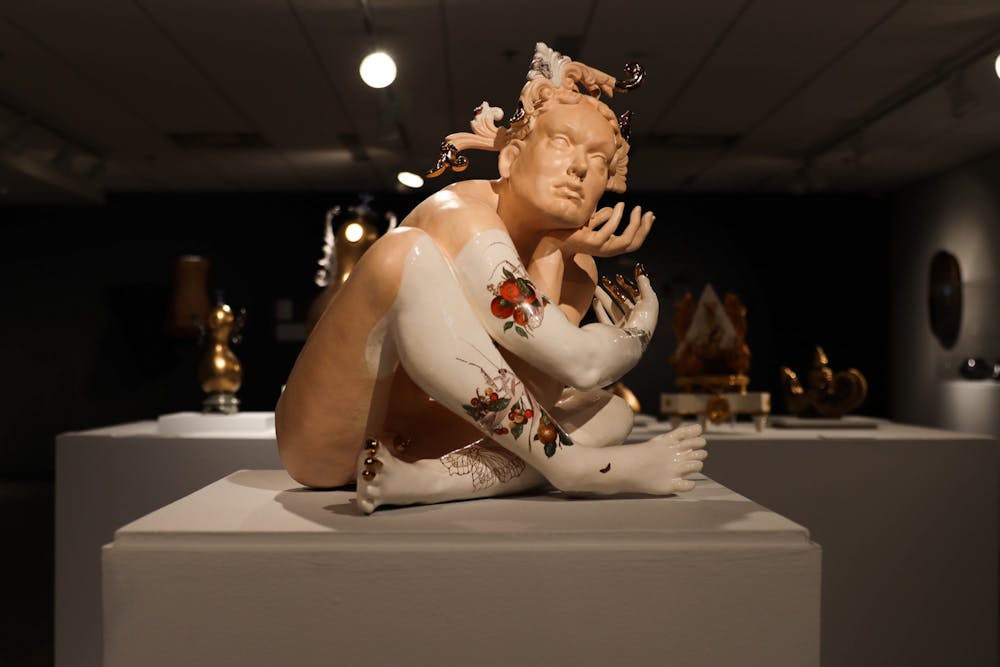Like a treasure trove of lost art from living generations, the Ceramic Research Center sits nearly buried under an engineering building, accessible only through an entrance between Sixth and Seventh streets in the aptly named "Brickyard."
Once inside, guests are welcomed to one of the most respected ceramic collections, hosted by a school with the fourth-ranked ceramic arts program in the nation, according to U.S. News and World Report.
Since first opening in 2002, the Ceramics Research Center has gone on to acquire over 4,000 pieces of ceramic art, around 800 of which are currently on display.
The open storage contains archived work from the 1950s onward and features well-known ceramists such as Robert Arneson, Toshiko Takaezu and Marilyn Levine, to name a few. A team of curators work to identify any anonymous pieces, said Sarah Kelly, Windgate Curator of Contemporary Craft and Design at the center.
"The center is only a handful of facilities in the world that combine access to an extensive ceramics collection, significant archival research materials and exhibition space," said Mary-Beth Buesgen, curator of the Ceramics Research Center and Archive.
The ceramics collection has grown steadily throughout the years through donations from local and national collectors, Buesgen said.
The curators' process includes a panoramic survey guided by principles of "innovation, risk taking and merit with a primary focus on work that explores social, political and environmental concerns in our regional and global contexts," Buesgen said.
The center prides itself on fostering a ceramics community unlike any other by welcoming anyone, from clay rookies to clay masters, said Susan Beiner, professor in the School of Art who specializes in ceramics.
READ MORE: A look into the ASU art museum's permanent collection
Under the leadership of ASU Art Museum director Miki Garcia, the museum sets the precedent for innovation through acquiring prints and craft, which Buesgen said "are often overlooked by institutions."
Susan Peterson, who moved to Scottsdale in 2008, was a clay-blazer and educator on the history of the form. She donated her entire ceramics collection and personal library to the museum, which accounts for around 800 pieces currently housed in the space. Thanks largely to Peterson's donation, the museum now houses over 3,000 titles of rare exhibition catalogues, books, periodicals and media.
One prized possession from the library is all 30 years worth of "The Studio Potter" magazine, a publication started in 1972 by editor Gerry Williams, which documented creative activity in the field of ceramics through criticism, oral histories, transcribed interviews, photos and journals. The library is now in the process of being digitized and can be accessed through an online database.
While the library and rotating permanent collection are accessible year-round, the museum also currently features "Luster and Light," a temporary Spring exhibit on display until mid-May.
"Luster and Light" contains work primarily from the museum’s permanent collection that feature a variety of materials such as gold and iridescent glass to create a lustrous appearance when paired with light, Kelly said.
The collection "asks if and how art museums encourage hierarchical thinking through the decisions they make about what kinds of objects they collect and display in their exhibitions," Kelly said.
Correction: A previous version of this article incorrectly stated the name of the art museum’s director. It also incorrectly stated the number of pieces Susan Peterson contributed. This article was updated March 3, 2022, at 7 p.m. to reflect the changes.
Reach the reporter at dmendrzy@asu.edu and follow @D3V0NWard on Twitter.
Like The State Press on Facebook and follow @statepress on Twitter.





